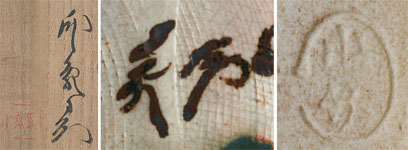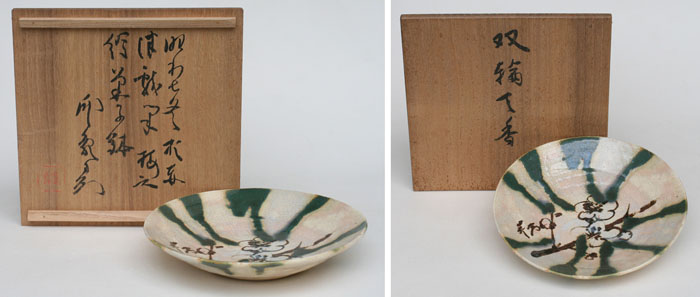Modern Nihonga
E-kashibashi, decorated bowl (dish) for sweets: Sôrin tenkô a pair of heavenly scenting wheels (Flowering plum twig,)Signed: Inshô
Seals: Shôchiku
Technique: A fine crackled glaze cloth formed gohonde Kyoyakai bowl with a brown underglaze tetsu-e painting with green and white slip and with uzu (Whirlpool) base Ø 19,3 x 3,8
Date: 1932
Box: signed by Inshô
Condition: fine
Dômoto Inshô with Fukuda Heihachirô (1892-1974) were considered Kyoto’s top Nihonga painters of their generation. Inshô was the more controversial of the two. He moved to abstract painting later, being the first of the Nihonga artists to do so.
Inshō was born in Kyoto where was educated in craft design. He drew patterns for textiles, but he pursued his studies in Nihonga painting between 1918-1924 at the Municipal College of Painting and as a pupil of Nishiyama Suishō (1879-1958). After he won a prize at the Teiten exhibition in 1925 for a large Buddhist painting he received commissions for several Buddhist temples, including Shitennōji in Osaka and Daigoji in Kyoto. During his lifetime he executed some 600 of these temple commissions.
But Inshō was equally at home in traditional Japanese styles and Western abstract painting. In 1952 he went to Europe as one of the first Nihonga painters to travel abroad after the war. His abstract works shook Japan, but started his career in the Western world with exhibitions in Paris, Turin and New York.
He regularly worked for the imperial household and was a member of the Japan Art Academy. In 1961 he received the Order of Culture. In 1966 he designed and built his own Dōmoto Art Museum in Kyoto to preserve and exhibit his work.
Reference:
Kyoto 1977
Roberts p. 19
Conant p. 291
Berry pp. 282-287 (# 80-81)
Goto # 153-154
Price: SOLD

